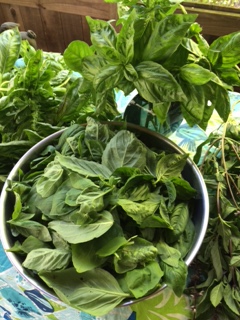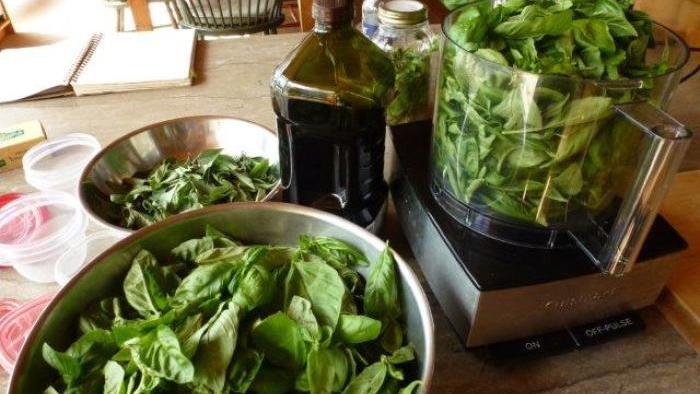
More than 40 years ago, I encountered pesto for the first time at an outdoor cafe in the romantic hills of Tuscany and I was immediately enamored. My love affair with basil began with my first bite of trenette al pesto. That first taste was one of surprise, delight, and intrigue. There is no preparation that better displays basil’s attributes than pesto and I was so enchanted with basil after that first night that I had to learn how to make pesto. Often referred to as Pesto alla Genovese, I knew the essential ingredients were an Italian green basil (preferably ‘Genoa Green’ or something similar), olive oil, garlic, parmesan, and pine nuts. I found the perfect teacher in Alberto, a young, enthusiastic Italian farmer with an aristocratic background, born and raised in Tuscany; he made pesto as his mother had taught him.
For my first pesto-making lesson, Alberto took me to his garden and we gathered basil and flat-leaved parsley (parsley is not a common ingredient in pesto, however it is an addition often found in the Tuscan version). We took the ingredients into the kitchen, where we started a pot of water to boil while we washed and dried the herbs. We pulled the leaves from their stems, grated Pecorino Romano (which is the preferred cheese for pesto in that region), and peeled garlic.
With the preparations completed, Alberto placed a handful of pignolia (pine nuts) and the garlic cloves in a large mortar and began pounding them with the pestle. He pounded the nuts and garlic into a rough paste and added a handful of basil and parsley. Once they were sufficiently pounded, he added more herbs, then a little olive oil, and then more herbs. We took turns using the pestle, it is a labor-intensive job, but the reward is in the end result. Alberto intuitively sensed the right amount of herbs to add, the precise amount of olive oil that was necessary for the perfect emulsion, and exactly how much cheese should be worked in to obtain just the right consistency and balance of flavor. We spooned the just-made pesto over al dente pasta. I was amazed again at the way I reacted to the magic of a mixture of simple, aromatic ingredients. In Italy, I was awakened to depth of flavor for the first time in my life and it changed forever my way of thinking about taste and food.
Now here, I must voice the opinion of most Italian cooks. Pesto alla Genovese must contain basil, garlic, olive oil, pine nuts and a hard, grating cheese such as Parmigniano Reggiano, Grana Padana or Pecorino Romano. There are variations in the different regions of Italy, however basil, garlic and olive oil are absolutely essential ingredients in pesto-otherwise it is NOT pesto. Nowadays, I go into restaurants and they feature cilantro pesto or arugula pesto or nettle pesto-these are not pestos-these are versions of a salsa verde, which is a green sauce that can be made with any herbs. A true Italian will valiantly defend this food of the gods: pesto is made from fresh Italian basil leaves.
Since my first encounters with pesto in Italy, I have made pesto more times and more ways than I can count. Pesto is a subject that can incite, or better yet, ignite the passion of many an Italian. Throughout the country, there are slight variations on the basic theme. The first preparation I learned was Tuscan and parsley was a-matter-of-fact ingredient; this would not be acceptable in Southern Italy. Parsley in pesto is unheard of there. Walnuts, however, can be used in place of pine nuts, which can cause shudders in other parts of the country. In the north, sometimes cream is added to pesto, which would cause great angst to a Sicilian, who might add a bit of tomato to their pesto. For as many regions as there are in Italy, there are more variations of pesto, however each version contains basil, garlic, olive oil, cheese and nuts.
Click this link for my recipe for Pesto alla Genovese from Basil: An Herb Lover’s Guide by Thomas DeBaggio and Susan Belsinger, Interweave Press, 1996. /item/129047/pesto-alla-genovese


















Comments
Log in or create an account to post a comment.
Sign up Log in